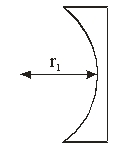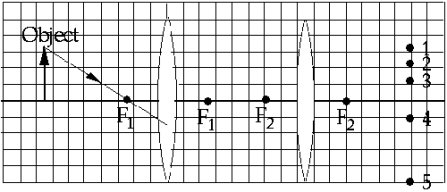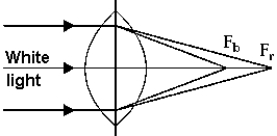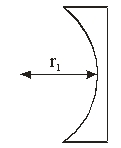A) 10
B) 50
C) 0.1
D) 0.2
E) 5
G) B) and C)
Correct Answer

verified
Correct Answer
verified
Multiple Choice
The theoretical limit to the sharpness of focus of a lens system is determined by
A) spherical aberration limitations.
B) chromatic aberration limitations.
C) astigmatic limitations.
D) diffraction limitations.
E) the relative smoothness of the lens surface.
G) A) and B)
Correct Answer

verified
Correct Answer
verified
Multiple Choice
 A plano-concave lens has r1 = 15 cm and is constructed of a material with refractive index of 1.5. The focal length of the lens is
A plano-concave lens has r1 = 15 cm and is constructed of a material with refractive index of 1.5. The focal length of the lens is
A) -15 cm
B) 15 cm
C) -30 cm
D) 30 cm
E) None of these is correct.
G) A) and C)
Correct Answer

verified
Correct Answer
verified
Multiple Choice
 Thin converging lenses 1 and 2 have focal points F1 and F2, respectively. After passing through the two lenses, the ray passes through point
Thin converging lenses 1 and 2 have focal points F1 and F2, respectively. After passing through the two lenses, the ray passes through point
A) 1
B) 2
C) 3
D) 4
E) 5
G) D) and E)
Correct Answer

verified
Correct Answer
verified
Multiple Choice
A jeweler's loupe (magnifying glass) has a focal length of 2.00 cm. Assuming that the loupe is held so that it forms an image at the normal near point of 25.0 cm, what magnification does it provide?
A) 46
B) 54
C) 11.5
D) 50
E) 15.4
G) A) and B)
Correct Answer

verified
Correct Answer
verified
Multiple Choice
 White light falls on a thick lens. The red wavelength and the blue wavelength fall at different focuses. The lens is said to exhibit
White light falls on a thick lens. The red wavelength and the blue wavelength fall at different focuses. The lens is said to exhibit
A) hypermetropia.
B) myopia.
C) astigmatism.
D) chromatic aberration.
E) spherical aberration.
G) A) and C)
Correct Answer

verified
Correct Answer
verified
Multiple Choice
An object is 10 cm from a concave spherical mirror whose radius is 10 cm. The image is
A) real, inverted, and magnified.
B) real, inverted, and diminished.
C) real, inverted, and the same size.
D) virtual, erect, and magnified.
E) virtual, erect, and diminished.
G) A) and C)
Correct Answer

verified
Correct Answer
verified
Multiple Choice
 An object is placed in front of a plano-concave lens at r1/2. The image produced by the lens is
An object is placed in front of a plano-concave lens at r1/2. The image produced by the lens is
A) inverted, real, and reduced in size.
B) inverted, virtual, and enlarged in size.
C) upright, virtual, and reduced in size.
D) upright, virtual, and enlarged in size.
E) upright, real, and enlarged in size.
G) C) and E)
Correct Answer

verified
Correct Answer
verified
Multiple Choice
A farsighted person uses glasses to read. The person then sees _____ print that appears _____ than is actually the case.
A) larger; closer
B) larger; farther away
C) smaller; closer
D) smaller; farther away
E) actual sized; farther away
G) D) and E)
Correct Answer

verified
Correct Answer
verified
Multiple Choice
 An object is located 3 cm from the surface of a silvered spherical glass Christmas tree ornament that is 3 cm in diameter. The image forms at
An object is located 3 cm from the surface of a silvered spherical glass Christmas tree ornament that is 3 cm in diameter. The image forms at
A) 1
B) 2
C) 3
D) 4
E) 5
G) A) and B)
Correct Answer

verified
Correct Answer
verified
Multiple Choice
A positive lens of focal length 40 cm is placed 20 cm behind a negative lens of focal length -80 cm. An object is placed 240 cm in front of the negative lens. The final image distance relative to the positive lens is
A) -40 cm
B) 56 cm
C) -56 cm
D) 80 cm
E) -80 cm
G) A) and C)
Correct Answer

verified
Correct Answer
verified
Multiple Choice
When an object is farther from a convex mirror than the mirror's focal point, the
A) magnification is less than one.
B) image distance is greater than the object distance.
C) magnification is equal to one.
D) image is real.
E) image is inverted.
G) D) and E)
Correct Answer

verified
Correct Answer
verified
Multiple Choice
Suppose your near point is 25.0 cm and you want to obtain a magnifying power of 20 with a simple magnifier. What focal-length lens should you choose?
A) 20 cm
B) 25 cm
C) 1.3 cm
D) 1.0 m
E) 80 cm
G) B) and D)
Correct Answer

verified
Correct Answer
verified
Multiple Choice
 The data in the graph were obtained using a thin lens. The lens must have been a
The data in the graph were obtained using a thin lens. The lens must have been a
A) converging lens of focal length 10 cm.
B) converging lens of focal length 5 cm.
C) diverging lens of focal length 10 cm.
D) diverging lens of focal length 5 cm.
E) flat-plate lens.
G) A) and B)
Correct Answer

verified
Correct Answer
verified
Multiple Choice
 A double-convex lens is made of glass of index of refraction 1.60. If the radii of curvature of the two surfaces are 10 cm and 20 cm, the focal length of the lens in air is
A double-convex lens is made of glass of index of refraction 1.60. If the radii of curvature of the two surfaces are 10 cm and 20 cm, the focal length of the lens in air is
A) 11.1 cm
B) -11.1 cm
C) 25 cm
D) 33.3 cm
E) -33.3 cm
G) A) and C)
Correct Answer

verified
Correct Answer
verified
Multiple Choice
Which type of aberration can be eliminated using mirrors instead of lenses?
A) chromatic aberration
B) spherical aberration
C) coma aberration
D) astigmatism
E) all the aberrations
G) D) and E)
Correct Answer

verified
Correct Answer
verified
Multiple Choice
Two people look at the same object through the same microscope. Person A has a near point of xnp and person B has a near point of 2xnp. If person A sees the object magnified m times, with what magnification does person B see the object?
A) m
B) m/2
C) m/4
D) 2m
E) 4m
G) All of the above
Correct Answer

verified
Correct Answer
verified
Multiple Choice
A lens of focal length -45 cm is used to correct the vision of a nearsighted person. Where is this person's far point?
A) 90 cm
B) 45 cm
C) 25 cm
D) 70 cm
E) 20 cm
G) C) and D)
Correct Answer

verified
Correct Answer
verified
Multiple Choice
The eyes of some people wearing glasses appear smaller than normal. The glasses help the people to see
A) better in the dark.
B) objects that are far away.
C) objects that are close by.
D) moving object better.
E) better in bright lights.
G) A) and B)
Correct Answer

verified
Correct Answer
verified
Multiple Choice
How far must a man's face be located in front of a concave spherical shaving mirror of radius 120 cm for him to see an erect image of his face four times its real size?
A) -75 cm
B) 45 cm
C) 75 cm
D) 90 cm
E) 150 cm
G) All of the above
Correct Answer

verified
Correct Answer
verified
Showing 21 - 40 of 143
Related Exams